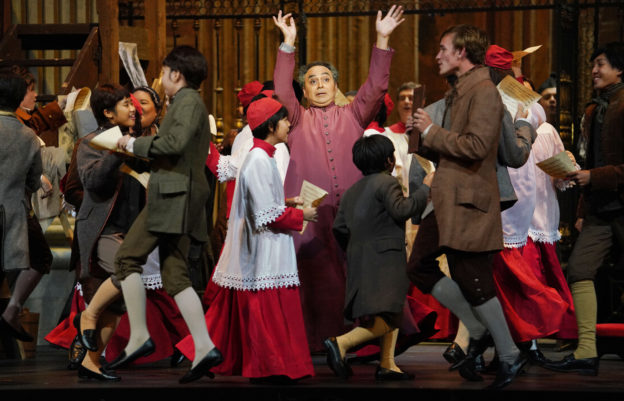
Review: ‘Tosca’ an outstanding season opener for Hawaii Opera Theatre
From The Honolulu Star-Advertiser
“Tosca” is known for its melodramatic love story, but it endures because of its core theme, a tug-of-war between piety and passion.
In a nutshell, the devout and passionate Floria Tosca is in love with the painter Cavaradossi, but is pursued by the depraved chief of police, Baron Scarpia. Within that triangle, the primary relationship and dramatic tension lie between Tosca and Scarpia. Cavaradossi serves as the noble everyman with whom audiences can identify while watching good and evil battle it out.
Hawaii Opera Theatre’s production, expertly cast and beautifully imagined, is simply outstanding.
Aleksey Bogdanov (Scarpia) is readily believable as evil incarnate, his powerful baritone dominating scenes, bullying everyone around him. Power- hungry, corrupt, lascivious, ruled by base passions, hypocritically pious, Scarpia is an unenviable role for singers: done well, everyone hates you. Bogdanov’s performance was almost too good: his sexual predation in Act II was stomach-churningly effective and the audience applauded when Tosca stabbed him.
As Tosca, Rochelle Bard proves a match for Scarpia, and her sweet little hands, so accustomed to prayer, proved strong enough to kill. Bard’s large, rich soprano creates a sympathetic Tosca who vascillates between piety and passion.
Her delivery of “Vissi d’arte” (“I lived for art”), the climactic Act II aria when she finally gives in to passions and loses her soul, is absolutely magical. The sheer beauty of Bard’s voice, coupled with impressive control on high pianissimo notes, raises goosebumps.
Alex Boyer as Cavaradossi is a sheer delight, the perfect partner for Tosca and contrast for Scarpia. His voice’s naturally high placement and warm clarity make Boyer a great heroic tenor: the world may be cruel, but his character is good through and through, singing above it all. Boyer’s wrenching “E lucevan le stelle” (“The stars were shining”), Cavaradossi’s Act III aria when he gives up life, brought the house down.
Tall, slender bass-baritone Jamie Offenbach makes a memorable Angelotti, Cavaradossi’s friend who opens the opera by staggering on stage, haggard and bloody from escaping Scarpia’s prison. His desperation is nicely balanced by the humor Jose Adan Perez injects as the bumbling, much-put-upon Sacristan.
Of special note are Scarpia’s lackeys, adeptly sung by members of HOT’s Young Artists Program, Nathaniel Catasca (Spoletta) and John Daugherty (Sciarrone).
Lavish scenic design by David P. Gordon garners its own applause, creating distinct worlds in each act: piety and love in a cathedral; torture and manipulation in Scarpia’s offices; and finally, Act III, when the curtain opens on a timeless setting for death: castle ramparts in the foreground, representing earthly might, juxtaposed against the cathedral’s dome and open skies in the background. Towering over it all is a large statue of Archangel Michael, swords in hand to battle for our souls, appearing at the moment of death to offer a chance to repent.
Kudos to director Omer Ben Seadia, making her HOT debut, whose staging is so closely integrated with Puccini’s music, measure by measure, that the music comes to life. Scenes unfold and transition naturally, even as Seadia creates spotlight moments for each character: Tosca’s “Vissi d’arte” is a frozen moment rising out of pure silence, Cavaradossi sings “E lucevan le stelle” as an aside, out of time, and in “Gia mi dicon venal” (“They call me venal”), Scarpia traps Tosca like a spider — all very effective.
Both chorus and orchestra deliver strong, tightly integrated and nuanced performances. Conductor Emmanuel Plasson keeps the large orchestra in balance so that singers and soloists can both be heard.
One of the great joys of “Tosca” is the interplay of parts, especially when the orchestra delivers the main melody over singers’ recitative and the sweet duets — Tosca and violin, Scarpia and flute, Cavaradossi and clarinet, both hallmarks of Puccini and highlighted by Plasson.
HOT’s “Tosca” conveys piety and passion in precarious balance, delivering a dynamite opening to its 2019-2020 season.
Running time is just under three hours, with two intermissions, and the opera is appropriate for mid-teenagers and older. The libretto for “Tosca” is condensed — every line matters — so keep an eye on the supertitles.
Ruth O. Bingham received her doctorate in musicology from Cornell University and has been reviewing the musical arts for more than 25 years.
